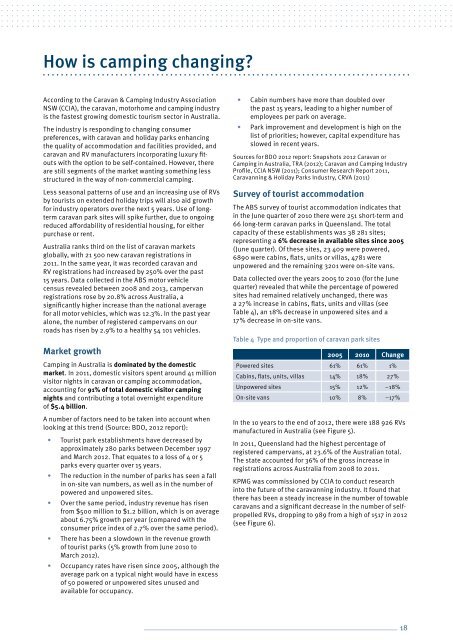qdts-camping-options-toolkit
qdts-camping-options-toolkit
qdts-camping-options-toolkit
Create successful ePaper yourself
Turn your PDF publications into a flip-book with our unique Google optimized e-Paper software.
How is <strong>camping</strong> changing?<br />
According to the Caravan & Camping Industry Association<br />
NSW (CCIA), the caravan, motorhome and <strong>camping</strong> industry<br />
is the fastest growing domestic tourism sector in Australia.<br />
The industry is responding to changing consumer<br />
preferences, with caravan and holiday parks enhancing<br />
the quality of accommodation and facilities provided, and<br />
caravan and RV manufacturers incorporating luxury fitouts<br />
with the option to be self-contained. However, there<br />
are still segments of the market wanting something less<br />
structured in the way of non-commercial <strong>camping</strong>.<br />
Less seasonal patterns of use and an increasing use of RVs<br />
by tourists on extended holiday trips will also aid growth<br />
for industry operators over the next 5 years. Use of longterm<br />
caravan park sites will spike further, due to ongoing<br />
reduced affordability of residential housing, for either<br />
purchase or rent.<br />
Australia ranks third on the list of caravan markets<br />
globally, with 21 500 new caravan registrations in<br />
2011. In the same year, it was recorded caravan and<br />
RV registrations had increased by 250% over the past<br />
15 years. Data collected in the ABS motor vehicle<br />
census revealed between 2008 and 2013, campervan<br />
registrations rose by 20.8% across Australia, a<br />
significantly higher increase than the national average<br />
for all motor vehicles, which was 12.3%. In the past year<br />
alone, the number of registered campervans on our<br />
roads has risen by 2.9% to a healthy 54 101 vehicles.<br />
Market growth<br />
Camping in Australia is dominated by the domestic<br />
market. In 2011, domestic visitors spent around 41 million<br />
visitor nights in caravan or <strong>camping</strong> accommodation,<br />
accounting for 91% of total domestic visitor <strong>camping</strong><br />
nights and contributing a total overnight expenditure<br />
of $5.4 billion.<br />
A number of factors need to be taken into account when<br />
looking at this trend (Source: BDO, 2012 report):<br />
• Tourist park establishments have decreased by<br />
approximately 280 parks between December 1997<br />
and March 2012. That equates to a loss of 4 or 5<br />
parks every quarter over 15 years.<br />
• The reduction in the number of parks has seen a fall<br />
in on-site van numbers, as well as in the number of<br />
powered and unpowered sites.<br />
• Over the same period, industry revenue has risen<br />
from $500 million to $1.2 billion, which is on average<br />
about 6.75% growth per year (compared with the<br />
consumer price index of 2.7% over the same period).<br />
• There has been a slowdown in the revenue growth<br />
of tourist parks (5% growth from June 2010 to<br />
March 2012).<br />
• Occupancy rates have risen since 2005, although the<br />
average park on a typical night would have in excess<br />
of 50 powered or unpowered sites unused and<br />
available for occupancy.<br />
• Cabin numbers have more than doubled over<br />
the past 15 years, leading to a higher number of<br />
employees per park on average.<br />
• Park improvement and development is high on the<br />
list of priorities; however, capital expenditure has<br />
slowed in recent years.<br />
Sources for BDO 2012 report: Snapshots 2012 Caravan or<br />
Camping in Australia, TRA (2012); Caravan and Camping Industry<br />
Profile, CCIA NSW (2011); Consumer Research Report 2011,<br />
Caravanning & Holiday Parks Industry, CRVA (2011)<br />
Survey of tourist accommodation<br />
The ABS survey of tourist accommodation indicates that<br />
in the June quarter of 2010 there were 251 short-term and<br />
66 long-term caravan parks in Queensland. The total<br />
capacity of these establishments was 38 281 sites;<br />
representing a 6% decrease in available sites since 2005<br />
(June quarter). Of these sites, 23 409 were powered,<br />
6890 were cabins, flats, units or villas, 4781 were<br />
unpowered and the remaining 3201 were on-site vans.<br />
Data collected over the years 2005 to 2010 (for the June<br />
quarter) revealed that while the percentage of powered<br />
sites had remained relatively unchanged, there was<br />
a 27% increase in cabins, flats, units and villas (see<br />
Table 4), an 18% decrease in unpowered sites and a<br />
17% decrease in on-site vans.<br />
Table 4 Type and proportion of caravan park sites<br />
2005 2010 Change<br />
Powered sites 61% 61% 1%<br />
Cabins, flats, units, villas 14% 18% 27%<br />
Unpowered sites 15% 12% –18%<br />
On-site vans 10% 8% –17%<br />
In the 10 years to the end of 2012, there were 188 926 RVs<br />
manufactured in Australia (see Figure 5).<br />
In 2011, Queensland had the highest percentage of<br />
registered campervans, at 23.6% of the Australian total.<br />
The state accounted for 36% of the gross increase in<br />
registrations across Australia from 2008 to 2011.<br />
KPMG was commissioned by CCIA to conduct research<br />
into the future of the caravanning industry. It found that<br />
there has been a steady increase in the number of towable<br />
caravans and a significant decrease in the number of selfpropelled<br />
RVs, dropping to 989 from a high of 1517 in 2012<br />
(see Figure 6).<br />
18


